new posts in all blogs
Viewing: Blog Posts Tagged with: 2016 picture book readalouds, Most Recent at Top [Help]
Results 1 - 5 of 5
How to use this Page
You are viewing the most recent posts tagged with the words: 2016 picture book readalouds in the JacketFlap blog reader. What is a tag? Think of a tag as a keyword or category label. Tags can both help you find posts on JacketFlap.com as well as provide an easy way for you to "remember" and classify posts for later recall. Try adding a tag yourself by clicking "Add a tag" below a post's header. Scroll down through the list of Recent Posts in the left column and click on a post title that sounds interesting. You can view all posts from a specific blog by clicking the Blog name in the right column, or you can click a 'More Posts from this Blog' link in any individual post.
 To be fair, every single picture book, with the exception of the wordless ones, is a readaloud. You’re not supposed to just silent there silent and stony when a child’s on your lap. Picture books are meant to engage through the voice of the reader. That said, not all of them do well when it comes to reading them to groups. When I first because a children’s librarian I learned the hard way that some classic titles (Horton Hatches the Egg, Blueberries for Sal, etc.) die ignoble deaths at your hands when read to groups of preschoolers. I began to rely on a core group of picture books with every storytime. The danger with that, though, is that you never try anything new.
To be fair, every single picture book, with the exception of the wordless ones, is a readaloud. You’re not supposed to just silent there silent and stony when a child’s on your lap. Picture books are meant to engage through the voice of the reader. That said, not all of them do well when it comes to reading them to groups. When I first because a children’s librarian I learned the hard way that some classic titles (Horton Hatches the Egg, Blueberries for Sal, etc.) die ignoble deaths at your hands when read to groups of preschoolers. I began to rely on a core group of picture books with every storytime. The danger with that, though, is that you never try anything new.
With all this in mind, these are some of the picture books of 2016 that I felt do particularly well when read to groups. Obviously there are other great ones out there. These are just the ones that come immediately to mind.
2016 Picture Book Readalouds: For Preschoolers
Box by Min Flyte, ill. Rosalind Beardshaw

About this time you’ll start noticing some duplication between my lists. The fact of the matter is that if a book is truly good, it isn’t just one thing. Box appeared already on the Board Book list, but that doesn’t mean it doesn’t do well as a readaloud too. So prepare for some familiar covers!
I Dare You! by Nicole Maubert
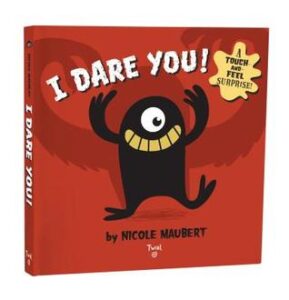 Try running around the room with this one, getting the kids to touch the witch’s warts, pet the monsters’ fur, and stick their hands in the slathering jaws of hungry beasts. As long as it keeps in one piece, it will be beloved.
Try running around the room with this one, getting the kids to touch the witch’s warts, pet the monsters’ fur, and stick their hands in the slathering jaws of hungry beasts. As long as it keeps in one piece, it will be beloved.
Monsters Go Night-Night by Aaron Zenz
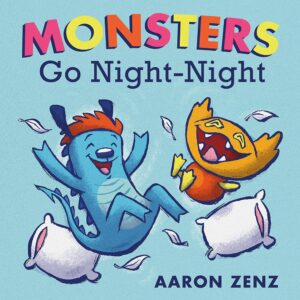
I adore this. I mean talk about a book that upsets expectations. I’m putting it on the younger list here because I can, but much like Mac Barnett and Adam Rex’s Guess Again (a highly underrated readaloud) this book upsets the expectations of its potentially jaded readership.
Grumpy Pants by Claire Messer
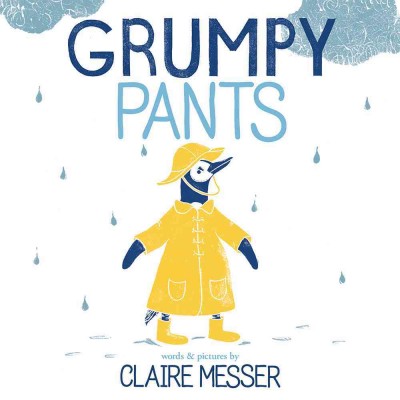
I had to be told by a children’s librarian in my branch that this book is a wonderful readaloud for groups. I knew it was lovely to look at but until she spoke up I never would have thought to consider it for large groups.
2016 Picture Book Readalouds: That You Can Sing
5 Little Ducks by Denise Fleming
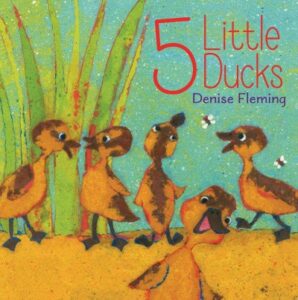
It still works if you don’t know the tune, but I think singing it is best. Plus look at that duck that’s front and center on the cover. How can you say no to that little guy?
Groovy Joe: Ice Cream & Dinosaurs by Eric Litwin, ill. Tom Lichtenheld
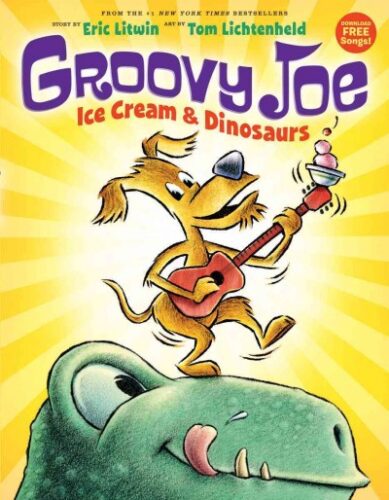
While the title does sound like free word associations for kids (“Name me two things your little brother would want at his birthday party”) this is the Pete the Cat author at work. The book’s pretty catchy. For the music, download the free song.
Old MacDonald Had a Truck by Steve Goetz, ill. Eda Kaban
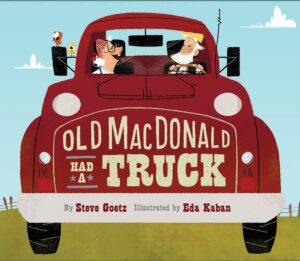
For years Jessica Souhami’s version of Old MacDonald was my favorite, and it may still be at the top of the ranking (WHEN is someone going to republish it?!???), but this book is gunning to be a close second. You’ve got Mrs. MacDonald welding, plenty of construction equipment, and just gorgeous art. Keep an eye on that Eda Kaban. That name may become better known in the future.
2016 Picture Book Readalouds: That Rhyme
A Dark, Dark Cave by Eric Hoffman, ill. Corey R. Tabor
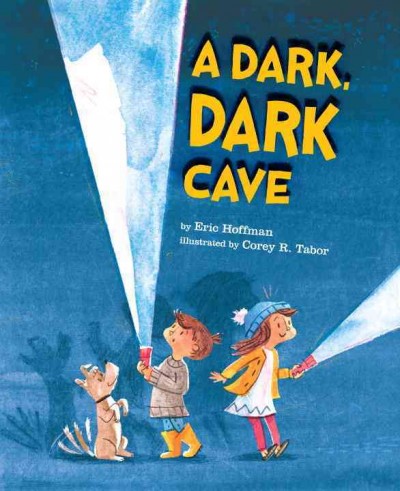
Aww. This was one of my favorites early in the year. It sort of reminds me of the Berenstain Bears classic Spooky Old Tree in a way. Fear, it seems, is a great motivator when coming up with picture book themes.
Dinosaur Rap by John Foster, ill. Debbie Harter, sung by Mikey Henry Jr.
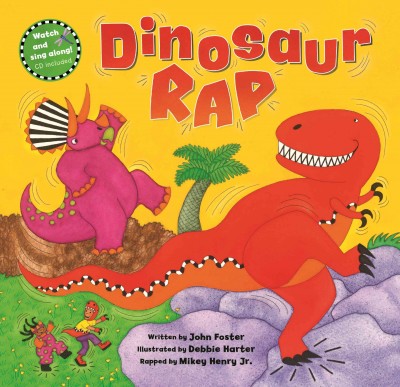
I usually avoid any book that includes the word “rap” anywhere near its title with a ten-foot-pole. But the bright art and fun rhymes convinced me otherwise. Technically I think it’s a song but I preferred reading it by itself. The rhymes hold up.
The Forgetful Knight by Michelle Robinson, ill. Fred Blunt
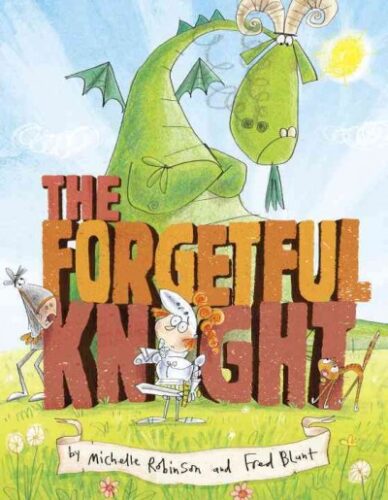
So much fun with a nice little twist at the end. And who doesn’t love a twist ending?
Hensel and Gretel Ninja Chicks by Corey Rosen Schwartz & Rebecca J. Gomez, ill. Dan Santat

Funny goes a long way with me, as you can probably tell.
A Toucan Can, Can You? by Danny Adlerman, ill. Various
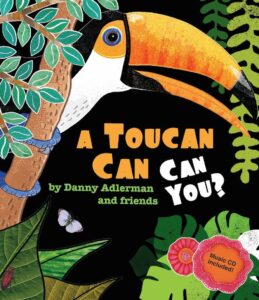
I think this is the first book on any of my lists to be reviewed on the site as well. Funny it took so long. Adlerman and company have created a truly funny book that also works as a writing assignment. Just smart stuff.
Swallow the Leader: A Counting Book by Danna Smith, ill. Kevin Sherry

More Kevin Sherry, please!
*holds out hand and makes a grabby motion*
2016 Picture Book Readalouds: For School Aged Kids
Chimpanzees for Tea! by Jo Empson
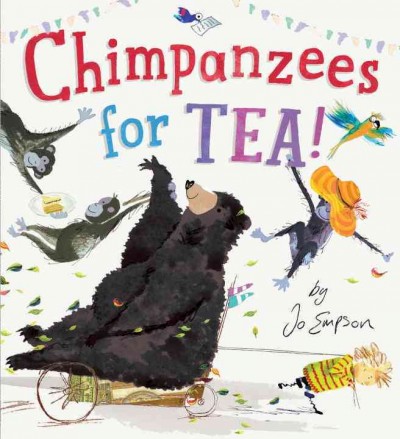
Remembering items from the story take a distinct turn for the silly in this book. I’m a sucker for readalouds where the kids get to yell at the characters for doing something wrong. In this case, the misremembered list builds to a nice chaotic frenzy over time. My favorite trope.
The Happiest Book Ever! by Bob Shea

If ever a humor award for picture book is created, Shea’s gonna sweep it every single year.
Hocus Pocus, It’s Fall! By Anne Sibley O’Brien
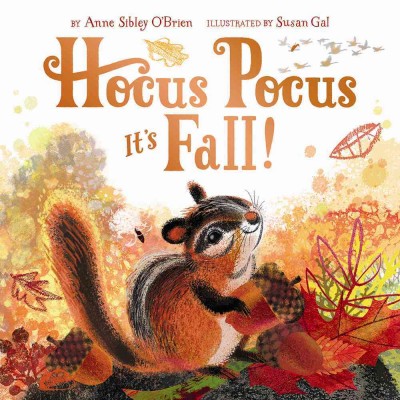
I know it’s seasonal, and usually I’d limit seasonal books to a different list, but I just loved this one. It has this little element where you open up a page to reveal something that works from a distance. Always important when reading to groups.
I Will Not Eat You by Adam Lehrhaupt, ill. Scott Magoon

You’ll pretty much have the kids hooked when you read and show them the title.
Is That Wise Pig? by Jan Thomas, Little Red and the Very Hungry Lion by Alex T. Smith

Jan Thomas could pretty much just repeat the same image over and over in a picture book and I’d find her work splendid. This is so funny and her art just pops. A kid in the next county could see it if you held it up. She’s also one of my storytime staples.
Leave Me Alone! by Vera Brosgol
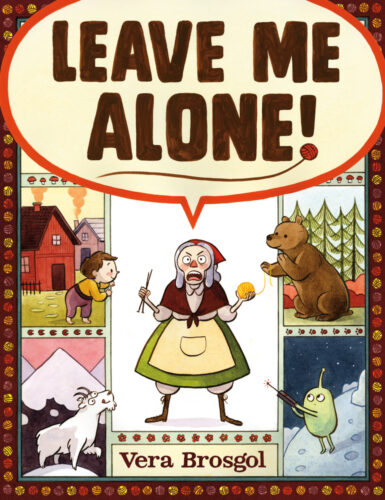
It’s perfect. No. Really. It is.
Max Speed by Stephen Shaskan
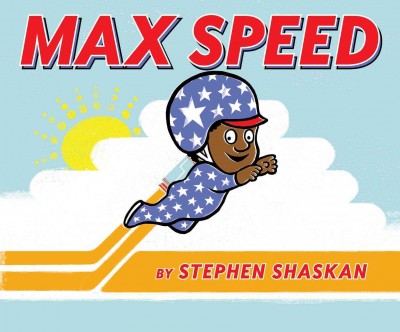
This was a huge hit at my kid’s daycare. I gave them a copy and they went gaga over it. And don’t worry. It has a happy ending.
One Day in the Eucalyptus Eucalyptus Tree by Daniel Bernstrom, ill. by Brendan Wenzel

To a certain extent this has been overshadowed by Wenzel’s other picture book this year They All Saw a Cat. That book has big readaloud potential in its own way, but if I were to have to pick between that and this one to read to a group, this would win every dang time. Hands down.
Panda Pants by Jacqueline Davies, ill. Sydney Hanson

I was trying to explain to my daughter today why pants are funny. What I should have done was just read her this book!
President Squid by Aaron Reynolds, ill. Sara Varon
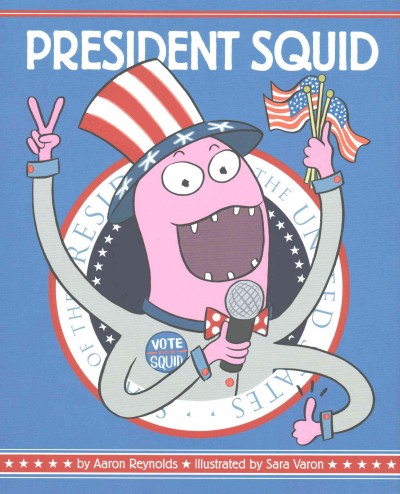
Read it. It’s cathartic. And don’t just do it once every four years either.
Quit Calling Me a Monster! by Jory John, ill. Bob Shea
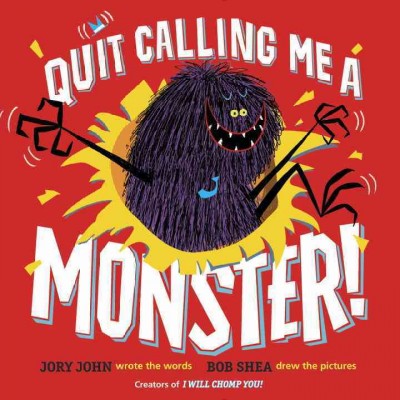
I MUCH prefer this over John & Shea’s previous outing I Will Chomp You. That book was fine. This one is sublime. I adore the hairy monster and his overly professional name.
That’s Not a Hippopotamus! by Juliette Maclver, ill. Sarah Davis
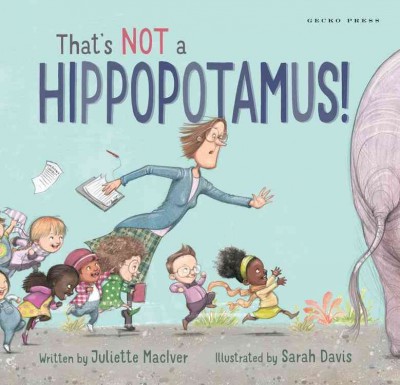
It’s frentic energy reminded me, just a little, of Hallie George’s Catch That Cookie! Had a GREAT ending too!
Interested in the other upcoming lists of this month? Here’s the schedule so that you can keep checking back:
December 1 – Board Books
December 2 – Board Book Adaptations
December 3 – Nursery Rhymes
December 4 – Picture Book Readalouds
December 5 – Rhyming Picture Books
December 6 – Alphabet Books
December 7 – Funny Picture Books
December 8 – Calde-Nots
December 9 – Picture Book Reprints
December 10 – Math Picture Books
December 11 – Bilingual Books
December 12 – International Imports
December 13 – Books with a Message
December 14 – Fabulous Photography
December 15 – Fairy Tales / Folktales
December 16 – Oddest Books of the Year
December 17 – Older Picture Books
December 18 – Easy Books
December 19 – Early Chapter Books
December 20 – Graphic Novels
December 21 – Poetry
December 22 – Fictionalized Nonfiction
December 23 – American History
December 24 – Science & Nature Books
December 25 – Transcendent Holiday Titles
December 26 – Unique Biographies
December 27 – Nonfiction Picture Books
December 28 – Nonfiction Chapter Books
December 29 – Novel Reprints
December 30 – Novels
December 31 – Picture Books


By:
Betsy Bird,
on 9/20/2016
Blog:
A Fuse #8 Production
(
Login to Add to MyJacketFlap)
JacketFlap tags:
Reviews,
picture books,
Chronicle,
Best Books,
Brendan Wenzel,
picture book readalouds,
Best Books of 2016,
2016 picture books,
2016 reviews,
Reviews 2016,
2017 Caldecott contenders,
2016 picture book readalouds,
Add a tag
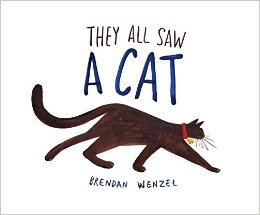 They All Saw a Cat
They All Saw a Cat
By Brendan Wenzel
Chronicle Books
$16.99
ISBN: 978-1-4521-5013-0
Ages 4-7
On shelves now
It’s funny. Unless you’re a teacher or librarian, a grown adult that does not work or live with children will come into very little contact with picture books. Then, one day, they produce a few kids and BLAMMO! They are shot into a world they haven’t visited since they were young themselves. They grab frantically at the classics, discover that a lot of them don’t work with very very young children (since when did Horton Hatches the Egg have so many words?!?), and then occasionally turn to the experts for help. And why? Parents’ reasons are not united on this front. Some read to their kids to instill a love of reading. Others to build little brains. Others to simply fill the long hours of the day. Occasionally a parent will also use a book to teach some kind of a lesson. If the parent is unlucky they will get stuck with a book sticky with didacticism (an unpleasant book that sucks all the joy out of the reading experience). But if they are lucky (or they are in the hands of a capable professional) they might find just the right book, teaching just the right lesson. Here’s an example: Let’s say you wanted to teach a kid empathy or how our perceptions change depending on our own experiences and who we are. How do you show that in 32 pages? Well, you could pick up some cloying, toxic dribble that overuses words like “hugs” and “friendship”. Nine times out of ten, that’s what’s going to happen. Or, if you are a clever parent, you pick up a book like They All Saw a Cat. It looks at first glance like it’s just about a cat. Delve a little deeper and you’ll find it about science and art and perception and empathy. And it does it all with very simple sentences, repetition, and a lot of white backgrounds. Not too shabby. Not too shabby at all.
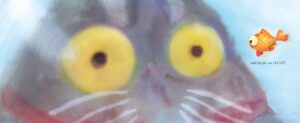 “The cat walked through the world, with its whiskers, ears, and paws . . .” In that walking it is seen. It is seen by a child, a dog, and a fox. It is seen by a fish, a mouse, and a bee. It is seen by a bird, a flea, a snake, a skunk, a worm, and a bat. And what’s important is that this “seeing” changes with every creature. For mice and dogs, the cat is perceived through the lens of their own interactions with it. For worms and bats the cat is only visible through the ways in which it moves through space (vibrations through the ground and the ways in which echolocation shape it). By the end we see a hodgepodge cat, a mix of how each animal sees it. Then the cat comes to the water, viewing its own reflection, “and imagine what it saw?”
“The cat walked through the world, with its whiskers, ears, and paws . . .” In that walking it is seen. It is seen by a child, a dog, and a fox. It is seen by a fish, a mouse, and a bee. It is seen by a bird, a flea, a snake, a skunk, a worm, and a bat. And what’s important is that this “seeing” changes with every creature. For mice and dogs, the cat is perceived through the lens of their own interactions with it. For worms and bats the cat is only visible through the ways in which it moves through space (vibrations through the ground and the ways in which echolocation shape it). By the end we see a hodgepodge cat, a mix of how each animal sees it. Then the cat comes to the water, viewing its own reflection, “and imagine what it saw?”
The book this actually reminded me of the most was that old Rudyard Kipling story “The Cat Who Walked By Himself”. Unlike that tale we never really get this book from the cat’s perspective. Indeed, the cat is often only visible when others see him. The similarity to Kipling comes with the language. That very first sentence, for example: “The cat walked through the world, with its whiskers, ears, and paws . . .” And as in the original art for that story, the cat here is often pictured from the back. There’s a lot of debate about whether or not a book written by one person and illustrated by another can ever be as strong as a book that is written and illustrated by the same artist. They All Saw a Cat makes a fairly strong argument that artist who are also authors are the better way to go. Wenzel’s sentences are so perfectly layered here. If anything, they match the personality of a cat. There aren’t many words, true. But the measured tone is at once soothing and scintillating. I liked how the book broke up the animals. The first three are potential predators. The second three are potential  prey. The final six are strict observers. It also ends perfectly with the best possible sentence. Not all picture books, no matter how beautiful they look, are capable of sticking their landings. This one does.
prey. The final six are strict observers. It also ends perfectly with the best possible sentence. Not all picture books, no matter how beautiful they look, are capable of sticking their landings. This one does.
In this book the publication page (where they tend to describe the artist’s process) gets a little slaphappy. It reads (and I am quoting this precisely), “The illustrations in this book were rendered in almost everything imaginable, including colored pencil, oil pastels, acrylic paint, watercolor, charcoal, Magic Marker, good old number 2 pencils, and even an iBook.” The other day I was listening to a podcast where one of the speakers speculated that including this kind of information in a book changes the adult reader’s perspective. Would I think less of this book if I found out it was done in digital ink? Possibly, though I should note that I was blown away by the art long before I ever turned to see how it was made. And while digital art is great and has its place, I’d like to see the program that replicates what Wenzel’s done here.
 The sheer beauty of the book is what strikes you first when you read it. Consider the two-page spread where on the left-hand side you see the cat through snake vision, and on the right-hand side you see the cat through skunk vision. The snake’s view is a vibrant shock of color, all yellows and reds and blues. The skunk’s in contrast, looks like the soft grainy sepia-tones of an old film. Maybe Casablanca. Put together, side-by-side, the same cat is its own opposite. But if Wenzel were constantly wowing you with eye-popping images that wouldn’t really support the narrative flow. That’s why the pacing of the book is key. Wenzel starts the book out very slowly, with lots of white backgrounds and views akin to what we see as people. The child, dog, and fox all see the cat similarly (though I loved the oversized bell around its neck, indicating the fox and dog’s superior sense of hearing through a visual medium). The fish is the first moment you start to separate from human visuals. The cat’s large, yellow eyes are 80% of the two pages. But it is the mouse’s Basquiat-esque view of the cat that steals the show. The red background, and the cat all teeth and claws, and terrifying eyes is a far cry from the cuddly creature at the start of the story. It’s also the moment when the child readers come to realize that perception is personal.
The sheer beauty of the book is what strikes you first when you read it. Consider the two-page spread where on the left-hand side you see the cat through snake vision, and on the right-hand side you see the cat through skunk vision. The snake’s view is a vibrant shock of color, all yellows and reds and blues. The skunk’s in contrast, looks like the soft grainy sepia-tones of an old film. Maybe Casablanca. Put together, side-by-side, the same cat is its own opposite. But if Wenzel were constantly wowing you with eye-popping images that wouldn’t really support the narrative flow. That’s why the pacing of the book is key. Wenzel starts the book out very slowly, with lots of white backgrounds and views akin to what we see as people. The child, dog, and fox all see the cat similarly (though I loved the oversized bell around its neck, indicating the fox and dog’s superior sense of hearing through a visual medium). The fish is the first moment you start to separate from human visuals. The cat’s large, yellow eyes are 80% of the two pages. But it is the mouse’s Basquiat-esque view of the cat that steals the show. The red background, and the cat all teeth and claws, and terrifying eyes is a far cry from the cuddly creature at the start of the story. It’s also the moment when the child readers come to realize that perception is personal.
An interesting criticism of this book is linked precisely to the more science-y aspects of the text. One of the commenters on a blog post I wrote, that included this book, said that, “I desperately wanted some nice science-y back matter to tell us how and why different animals see the cat the way they do. Sure, we can go OH, this animal must be colorblind! This animal ‘sees’ by sonar! But c’mon, throw us an edu-bone here. It felt like such a missed opportunity.” This is an interesting note. We’ve grown used to useful backmatter in this post-Core Curriculum world of ours. Would this book have been stronger if it had contained a science element to it? Yes and no. It would have been a real boon to teachers, you betcha, and probably to perceptive parents who could have turned it into a lesson for young readers. If I had to guess I’d say the reason it wasn’t done may have had something to do with the fact that Wenzel is mixing his fact and fiction here pretty closely. Each animal is “seeing” as it would in the wild, but that is not to say that the art is by any means scientific. The cartoonish quality to the animals (no better exemplified than in the mouse’s bulbous eyes) doesn’t hold up to close scrutiny. I would have very much liked notes on the accuracy of the art, but I can understand the fear of asking the reader to take the work too seriously. I don’t necessarily agree, but I understand it.
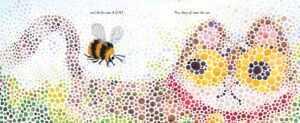 How do you discuss this book with kids? Well, you might read it to them, start to finish, and then ask them which picture shows what the cat really looks like. When they select (some will go with the human view but I’ve no doubt a couple will prefer the dog or bird p.o.v.s) you then tell them that actually all the pictures in this book are true. And if you really want to blow their little minds, you tell them that there’s a good chance that the way you see the world isn’t the same way the person next to you does. Everyone, everywhere sees the world different from his or her neighbor. Is it any wonder we have problems? The solution is to try and see things from another person’s view. Now, if the kids think you’re speaking literally or figuratively, it doesn’t really matter. You’ve planted the seed. Or, rather, the book has.
How do you discuss this book with kids? Well, you might read it to them, start to finish, and then ask them which picture shows what the cat really looks like. When they select (some will go with the human view but I’ve no doubt a couple will prefer the dog or bird p.o.v.s) you then tell them that actually all the pictures in this book are true. And if you really want to blow their little minds, you tell them that there’s a good chance that the way you see the world isn’t the same way the person next to you does. Everyone, everywhere sees the world different from his or her neighbor. Is it any wonder we have problems? The solution is to try and see things from another person’s view. Now, if the kids think you’re speaking literally or figuratively, it doesn’t really matter. You’ve planted the seed. Or, rather, the book has.
Let us do away with the notion of “cat people” vs. “dog people”. This book is for “people”. End of sentence. And if I got a little crazy in my first paragraph here, filling you in on my view of world peace via picture books, you’ll understand when you read this book. That tired old phrase to “walk a mile in someone else’s shoes” makes no sense to a kid. But travel a page through another animal’s eyes? There’s never been a better fictional picture book that allows you to do this. If we all see something as simple as a cat this differently, what else might we not see the same? It’s a treat to eye, ear, and mind, but don’t forget. We’re all going to see this book through our own lenses. What will your kids see when they look at it? Only one way to find out.
On shelves now.
Source: Galley sent from publisher for review.
Like This? Then Try:
Professional Reviews:
Other Mentions:
Videos:


By:
Betsy Bird,
on 8/24/2016
Blog:
A Fuse #8 Production
(
Login to Add to MyJacketFlap)
JacketFlap tags:
Canadian picture books,
picture book readalouds,
2016 picture books,
2016 reviews,
Reviews 2016,
2016 picture book readalouds,
Reviews,
picture books,
Canadian children's books,
Tundra Books,
Bill Slavin,
Add a tag
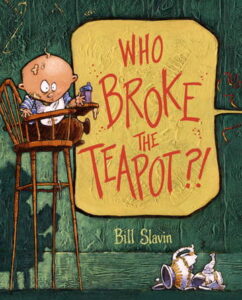 Who Broke the Teapot?!
Who Broke the Teapot?!
By Bill Slavin
Tundra Books
$16.99
ISBN: 978-1-77049-833-4
Ages 3-5
On shelves now
In the average life of a child, whodunits are the stuff of life itself. Who took the last cookie? Who used up all the milk and then didn’t put it on the shopping list? Who removed ALL the rolls of toilet paper that I SPECIFICALLY remember buying at the store on Sunday and now seem to have vanished into some toilet paper eating inter-dimension? The larger the family, the great the number of suspects. But picture books that could be called whodunits run a risk of actually going out and teaching something. A lesson about honesty or owning up to your own mistakes. Blech. I’ll have none of it. Hand me that copy of Bill Slavin’s Who Broke the Teapot?! instead, please. Instead of morals and sanctity I’ll take madcap romps, flashbacks, and the occasional livid cat. Loads of fun to read aloud, surprisingly beautiful to the eye, and with a twist that no one will see coming, Who Broke the Teapot?! has it all, baby. Intact teapot not included.
The scene of the crime: The kitchen. The family? Oblivious. As the mother enters the room it’s just your average morning. There’s a baby in a high chair, a brother attached to a ceiling fan by his suspenders, a dad still in his underwear reading the paper, a daughter eating pastries, a dog aiding her in this endeavor, and a cat so tangled up in wool that it’s a wonder you can still make out its paws. And yet in the doorway, far from the madding crowd, sits a lone, broken, teapot. Everyone proclaims innocence. Everyone seems trustworthy in that respect. Indeed, the only person to claim responsibility is the baby (to whom the mother tosses a dismissive, “I doubt it”). Now take a trip back in time just five minutes and all is revealed. The true culprit? You’ll have to read the book yourself. You final parting shot is the mother accepting a teapot stuck together with scotch tape and love from her affectionate offspring.
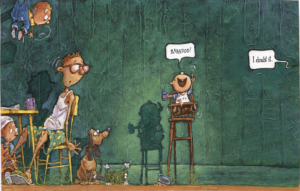 Generally when I write a picture book review I have a pretty standard format that I adhere to. I start with an opening paragraph (done), move on to a description of the plot in the next paragraph (so far, so good), and in the third paragraph I talk about some aspect of the writing. It could be the overall theme or the writing or the plotting. After that I talk about the art. This pattern is almost never mucked with . . . until today!! Because ladies and gents, you have just GOT to take a gander at what Mr. Slavin’s doing here with his acrylics. Glancing at the art isn’t going to do it. You have to pick this book up and really inspect the art. For the bulk of it the human characters are your usual cartoony folks. Very smooth paints. But even the most cursory glance at the backgrounds yields rewards. The walls are textured with thick, luscious paints adhering to different patterns. There’s even a touch of mixed media to the old affair, what with cat’s yarn being real thread and all (note too how Slavin seamlessly makes it look as if the yarn is wrapped around the legs of the high chair). Then the typography starts to get involved. The second time the mom says “Who broke the teapot?!” the words look like the disparate letters of a rushed ransom note. As emotions heat up (really just the emotions of the mom, to be honest) the thick paints crunch when she says “CRUNCHED”, acquire zigzags as her temper unfurls, and eventually belie the smoothness of the characters’ skin when the texture invades the inside of the two-page spread of the now screaming mother’s mouth.
Generally when I write a picture book review I have a pretty standard format that I adhere to. I start with an opening paragraph (done), move on to a description of the plot in the next paragraph (so far, so good), and in the third paragraph I talk about some aspect of the writing. It could be the overall theme or the writing or the plotting. After that I talk about the art. This pattern is almost never mucked with . . . until today!! Because ladies and gents, you have just GOT to take a gander at what Mr. Slavin’s doing here with his acrylics. Glancing at the art isn’t going to do it. You have to pick this book up and really inspect the art. For the bulk of it the human characters are your usual cartoony folks. Very smooth paints. But even the most cursory glance at the backgrounds yields rewards. The walls are textured with thick, luscious paints adhering to different patterns. There’s even a touch of mixed media to the old affair, what with cat’s yarn being real thread and all (note too how Slavin seamlessly makes it look as if the yarn is wrapped around the legs of the high chair). Then the typography starts to get involved. The second time the mom says “Who broke the teapot?!” the words look like the disparate letters of a rushed ransom note. As emotions heat up (really just the emotions of the mom, to be honest) the thick paints crunch when she says “CRUNCHED”, acquire zigzags as her temper unfurls, and eventually belie the smoothness of the characters’ skin when the texture invades the inside of the two-page spread of the now screaming mother’s mouth.
So, good textures. But let us not forget in all this just how important the colors of those thick paints are as well. Watching them shift from one mood to another is akin to standing beneath the Northern Lights. You could be forgiven for not noticing the first, second, third, or even fourth time you read the book. Yet these color changes are imperative to the storytelling. As emotions heat up or the action on the page ramps up, the cool blues and greens ignite into hot reds, yellows, and oranges. Taken as a whole the book is a rainbow of different backgrounds, until at long last everything subsides a little and becomes a chipper cool blue.
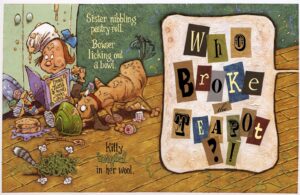 Now kids love a good mystery, and I’m not talking just the 9 and 10-year-olds. Virtually every single age of childhood has a weakness for books that set up mysterious circumstances and then reveal all with a flourish. Heck, why do you think babies like the game of peekaboo? Think of it as the ultimate example of mystery and payoff. Picture book mysteries are, however, far more difficult to write than, say, an episode of Nate the Great. You have to center the book squarely in the child’s universe, give them all the clues, and then make clear to the reader what actually happened. To do this you can show the perpetrator of the crime committing the foul deed at the start of the book or you can spot clues throughout the story pointing clearly to the miscreant. In the case of Who Broke the Teapot, Slavin teaches (in his own way) that old Sherlock Holmes phrase, “When you have eliminated the impossible, whatever remains, however improbable, must be the truth.”
Now kids love a good mystery, and I’m not talking just the 9 and 10-year-olds. Virtually every single age of childhood has a weakness for books that set up mysterious circumstances and then reveal all with a flourish. Heck, why do you think babies like the game of peekaboo? Think of it as the ultimate example of mystery and payoff. Picture book mysteries are, however, far more difficult to write than, say, an episode of Nate the Great. You have to center the book squarely in the child’s universe, give them all the clues, and then make clear to the reader what actually happened. To do this you can show the perpetrator of the crime committing the foul deed at the start of the book or you can spot clues throughout the story pointing clearly to the miscreant. In the case of Who Broke the Teapot, Slavin teaches (in his own way) that old Sherlock Holmes phrase, “When you have eliminated the impossible, whatever remains, however improbable, must be the truth.”
I love it when a book turns everything around at the end and asks the reader to think long and hard about what they’ve just seen. Remember the end of The Cat in the Hat when everything’s been cleaned up just in time and the mother comes in asking the kids what they got up to while she was gone? The book ends with a canny, “Well, what would YOU do if your mother asked YOU?” Who Broke the Teapot?! does something similar at its end as well. The facts have been laid before the readers. The baby has claimed responsibility and maybe he is to blame after all. But wasn’t the mother just as responsible? It would be very interesting indeed to poll a classroom of Kindergartners to see where they ascribe the bulk of the blame. It may even say something about a kid if they side with the baby more or the mommy more.
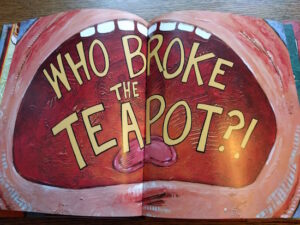 I also love that the flashback does far more than explain who broke the teapot. It explains why exactly most of the members of this family are dwelling in a kind of generally accepted chaotic stew. You take it for granted when you first start reading. A kid’s hanging from a ceiling fan? Sure. Yeah. That happens. But the explanation, when it comes, belies that initial response. The parents don’t question his position so you don’t question it. That is your first mistake. Never take your lead from parents. And speaking of the flashback, let’s just stand aside for a moment and remember just how sophisticated it is to portray this concept in a picture book at all. You’re asking a child audience to accept that there is a “before” to every book they read. Few titles go back in time to explain how we got to where we are now. Slavin’s does so easily, and it will be the rare reader that can’t follow him on this trip back into the past.
I also love that the flashback does far more than explain who broke the teapot. It explains why exactly most of the members of this family are dwelling in a kind of generally accepted chaotic stew. You take it for granted when you first start reading. A kid’s hanging from a ceiling fan? Sure. Yeah. That happens. But the explanation, when it comes, belies that initial response. The parents don’t question his position so you don’t question it. That is your first mistake. Never take your lead from parents. And speaking of the flashback, let’s just stand aside for a moment and remember just how sophisticated it is to portray this concept in a picture book at all. You’re asking a child audience to accept that there is a “before” to every book they read. Few titles go back in time to explain how we got to where we are now. Slavin’s does so easily, and it will be the rare reader that can’t follow him on this trip back into the past.
I think the only real mystery here is why this book isn’t better known. And its only crime is that it’s Canadian, and therefore can’t win any of the big American awards here in the States. It’s also too amusing for awards. Until we get ourselves an official humor award for children’s books, titles like Who Broke the Teapot?! are doomed to fly under the radar. That’s okay. This is going to be the kind of book that children remember for decades. They’re going to be the ones walking into their public libraries asking the children’s librarians on the desks to bring to them an obscure picture book from their youth. “There was a thing that was broken . . . like a china plate or something . . . and there was this cat tied up in string?” You have my sympathies, children’s librarians of the future. In the meantime, better enjoy the book now. Whether it’s read to a large group or one-on-one, this puppy packs a powerful punch.
On shelves now
Source: Publisher sent final copy for review.
Like This? Then Try:


By:
Betsy Bird,
on 7/14/2016
Blog:
A Fuse #8 Production
(
Login to Add to MyJacketFlap)
JacketFlap tags:
Megan Halsey,
Wendy Anderson Halperin,
picture book readalouds,
2016 picture books,
2016 reviews,
Reviews 2016,
2016 picture book readalouds,
Christee Curran-Bauer,
Danny Adlerman,
Dar (Hosta),
Jim Babjak,
Kevin Kammeraad,
Kim Adlerman,
picture book song books,
Ralph Masiello,
Symone Banks,
The Kids at Our Home,
Reviews,
Lindsay Barrett George,
Demi,
Ashley Wolff,
Leeza Hernandez,
Pat Cummings,
Add a tag
 A Toucan Can, Can You?
A Toucan Can, Can You?
By Danny Adlerman
Illustrated by Lindsay Barrett George, Megan Halsey, Ashley Wolff, Demi, Ralph Masiello, Wendy Anderson Halperin, Kevin Kammeraad, Pat Cummings, Dar (Hosta), Leeza Hernandez, Christee Curran-Bauer, Kim Adlerman, and Symone Banks
Music by Jim Babjak
The Kids at Our House Children’s Books
$19.95
ISBN: 9781942390008
Ages 3-6
On shelves now
Under normal circumstances I don’t review sequels. I just don’t, really. Sequels, generally speaking, require at least a rudimentary knowledge of the preceding book. If I have to spend half a review catching a reader up on the book that came before the book that I’m actually reviewing, that’s just a waste of everyone’s time. Better to skip sequels entirely, and I include chapter book sequels, YA sequels, middle grade sequels, nonfiction sequels, graphic novel sequels, and easy book sequels in that generalization. I would even include picture book sequels, but here I pause for a moment. Because once in a while a picture book sequel will outshine the original. Such is the case with Danny Adlerman’s audibly catchy and visually eclectic A Toucan Can, Can You? A storyteller’s (and song-and-dance parent’s) dream, the book is is a sequel to the book How Much Wood Could a Woodchuck Chuck but comes into its own as a writing assignment for some, a storytime to others, and a darn good book for everybody else.
Many of us are at least passingly familiar with that old poem, “How much wood could a woodchuck chuck if a woodchuck could chuck wood?” But why stop with the woodchuck? What other compound words can you break up in amusing ways? And so we are sucked into a delightful world of teaspoons spooning tea, spaceships shipping space, and ice cream screaming “ice!” Each one of these catchy little poems (which are set to music on the accompanying CD) is paired with art from an impressive illustrator. Part collaboration and part exercise in audible frivolity, Danny Adlerman’s little book packs a great big punch.
For a group collaboration to work in a picture book there needs to be a reason for it to even exist. Which is to say, why have different people do different pieces of art for the same book? To best justify bringing these artists together you need a strong hook. And brother, I can’t think of a stronger hook then a catchy little rhyme, turned into a song, and given some clever additional rhymes to go along with it. Let’s hear it for the public domain! It’s little wonder that the customary “Note to Parents and Teachers” found in books of this sort appears at the beginning of the book rather than the end. In it, mention is made of the fact that the accompanying CD has both music with the lyrics and music without the lyrics, allowing kids to make up their own rhymes. I can attest as someone who did storytimes for toddlers and preschoolers for years that music can often be a librarian’s best friend. Particularly if it has a nice little book to show off as well. So for the storytimes for younger children, go with the words. And for the older kids? I think a writing assignment is waiting in the wings.
I was quite taken with the rhymes that already exist in this book, though. In fact, my favorite (language-wise) might have to be “How much bow could a bow tie tie if a bow tie could tae bo?” if only because “tae bo” makes shockingly few cameos in picture books these days. Finding the perfect collaboration between word and text can be difficult but occasionally the book hits gold. One example would be on the rhyme “How much ham could a hamster stir if a hamster could stir ham?” Artist Leeza Hernandez comes up with a rough riding hamster in cowboy gear astride an energetic hog. Two great tastes that taste great together.
Obviously the problem with any group collaboration is that some pieces are going to be stronger than others. But I have to admit that when I looked at that line-up I was a bit floored. In an impressive mix of established artists and new up-and-comers, Adlerman pairs his illustrators alongside rhymes that best show off their talents. Demi, for example, with her meticulous details and intricate style, is perfectly suited to honeycombs, honey, and the thin veins in the wing of a honeybee, holding a comb aloft. Meanwhile Wendy Anderson Halperin tackles the line “How much paint could a paintbrush brush” by rendering a variety of famous works, from Magritte to Diego Rivera in her two-page spread. Mind you, some artists are more sophisticated than others, and the switch between styles threatens to give one a bit of whiplash in the process. Generally speaking, however, it’s lovely. And I must confess that it was only on my fourth or fifth reading that I realized that the lovely scene illustrated by newcomer Symone Banks at the end of the book is dotted with animals done by the other artists, hidden in the details.
I don’t have to do storytimes anymore. In my current job my contact with kids is fairly minimal. But I have a two-year-old and a five-year-old at home and that means all my performance skills are on call whenever those two are around. I admit it. I need help. And books like A Toucan Can: Can You? can be lifesavers to parents like myself. If we had our way there would be a book-of-the-week club out there that personally delivered song-based picture books to our door. Heck, it should be a book-of-the-DAY club. I mean, let’s be honest. Raise a glass then and toast to Danny Adlerman and his fabulous friends. Long may their snowshoes shoo, their jellyfish fish, and their rockhoppers hop hop hop.
On shelves now.
Like This? Then Try:
Source: Galley sent from author for review.


By:
Betsy Bird,
on 4/28/2016
Blog:
A Fuse #8 Production
(
Login to Add to MyJacketFlap)
JacketFlap tags:
picture books,
Harper Collins,
Best Books,
Katherine Tegen Books,
Brendan Wenzel,
preschool storytime readalouds,
picture book readalouds,
Best Books of 2016,
2016 picture books,
2016 reviews,
Reviews 2016,
2016 picture book readalouds,
Daniel Bernstrom,
Reviews,
Add a tag
 One Day in the Eucalyptus, Eucalyptus Tree
One Day in the Eucalyptus, Eucalyptus Tree
By Daniel Bernstrom
Illustrated by Brendan Wenzel
Katherine Tegen Books (an imprint of Harper Collins)
$17.99
ISBN: 978-0-06-235485-3
Ages 3-6
On shelves May 3rd
Like any children’s librarian, I like to assess each picture book that crosses by my eyeballs for readaloud potential. While every picture book (even the wordless ones) can be read aloud to a large group of children, only a select few thrive in that environment. It takes a certain magical combination of art and text to render a story readaloud-perfect. Books you can sing have a leg up. Ditto books with flaps or pull-tabs. But the nice thing about Bernstrom’s book One Day in the Eucalyptus, Eucalyptus Tree is that it doesn’t need to rely on those extra features to enrapture an audience. The book’s lilting rhymes, when practiced beforehand, have the potential to render an audience entranced. Add in the art of Brendan Wenzel, and how well it reads across a room, and you’ve got yourself the makings of what might possibly be the best readaloud picture book of the year.
A boy and his whirly-twirly toy are just the first things to disappear down the gullet of a hungry yellow snake. But rather than bemoan his fate, the boy gets to work in his new role as the snake’s inner id. Commenting on the sheer amount of room and space in the belly, the boy cajoles the snake into eating more and more and more. From birds and worms, to mossy sloths, to a single apple bearing a tiny fly, the creatures slide down the snake’s rapidly expanding throat. A final meal proves too much for the voracious viper and next thing you know boy, toy, and a host of other animals are upchucked back into the world from whence they came. A sly illustration at the end suggests that history may repeat itself soon.
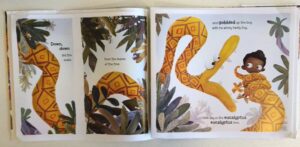 It’s not as if Mr. Bernstrom is the first person to find the word “eucalyptus” so exceedingly delicious to both tongue and ear, but he certainly seems to have been the most prominent in recent memory. As I read the book the language of the reading triggered something in my brain. Something long forgot. And though his name evokes strong feelings in every possible direction, it was Rudyard Kipling I thought of as I read this tale. Specifically the tale of “How the Elephant Got His Trunk”. Though that story does not realize how superb the word “eucalyptus” is when repeated, Kipling got a great deal of mileage out of illustrating thoughts with words. Terms like “great grey greasy Limpopo river”, “Kolokolo Bird”, and “the Bi-Coloured-Python-Rock-Snake” make those of us reading the stories aloud sound good. Bernstrom is writing for a younger audience so he doesn’t flex his muscles quite as far as Kipling did, but at the same time you recognize that he has the potential to do so. One hopes his future publishing plans may include longer stories just meant for sharing aloud. Lord knows we need more authors like that these days.
It’s not as if Mr. Bernstrom is the first person to find the word “eucalyptus” so exceedingly delicious to both tongue and ear, but he certainly seems to have been the most prominent in recent memory. As I read the book the language of the reading triggered something in my brain. Something long forgot. And though his name evokes strong feelings in every possible direction, it was Rudyard Kipling I thought of as I read this tale. Specifically the tale of “How the Elephant Got His Trunk”. Though that story does not realize how superb the word “eucalyptus” is when repeated, Kipling got a great deal of mileage out of illustrating thoughts with words. Terms like “great grey greasy Limpopo river”, “Kolokolo Bird”, and “the Bi-Coloured-Python-Rock-Snake” make those of us reading the stories aloud sound good. Bernstrom is writing for a younger audience so he doesn’t flex his muscles quite as far as Kipling did, but at the same time you recognize that he has the potential to do so. One hopes his future publishing plans may include longer stories just meant for sharing aloud. Lord knows we need more authors like that these days.
The story itself sounds familiar when you read it, but that may have to do more with familiar tropes than a tale we’ve actually seen done. The book also taps into a very popular method of extracting eaten creatures from predators’ bellies: burping. Vomiting works too, though the word sounds more disgusting, so usually in cases like this book the critters are released in a big old burp. In this case, we’re basically seeing a nature-based version of that Monty Python skit where the diner is persuaded to eat one final item (“It’s wafer-thin”). It’s odd to enjoy so much a book where a kid tricks the animal it is within to throw up, but there you go. The storytelling itself is top notch too, though I had a moment of confusion when the snake ate the beehive. Seems to me that that moment is where the boy’s plan potentially takes a turn south. Being stuck in a snake’s belly is one thing. Being stuck in a snake’s belly with flying, stinging insects? Thanks but no.
 Illustrator Brendan Wenzel burst onto the children’s picture book illustration scene in 2014 but his rise in prominence since that time has been slow. The artist first caught everyone’s eye when he illustrated Angela DiTerlizzi’s Some Bugs but it was the cover art of Ellen Jackson’s Beastly Babies the following year that was the most eye-catching. That cover sold that book. An ardent conservationist, it makes a lot of sense to turn to Wenzel when you’ve a story chock full of sloths, snakes, and bees. With Bernstrom’s tale, Wenzel must render this tale in the style of There Was an Old Lady Who Swallowed a Fly. Which is to say, he needs to balance horror with humor. Books where the protagonist gets eaten are common. Books where the protagonist gets eaten and then continues to comment on the action are rare. Wenzel’s snake falls into that category of villains that must be vicious enough to serve as a legitimate threat, but tame enough that a four-year-old won’t fear them on sight. To do this, Wenzel’s art takes on a distinctly jovial tone that treads towards the cartoonish without ever falling in completely. The colors are bright but not overwhelming, just as the action is consistent without horrifying the audience. Most of the creatures handle being eaten with gentle good grace (though the sloth looks more than a little put out about the whole thing).
Illustrator Brendan Wenzel burst onto the children’s picture book illustration scene in 2014 but his rise in prominence since that time has been slow. The artist first caught everyone’s eye when he illustrated Angela DiTerlizzi’s Some Bugs but it was the cover art of Ellen Jackson’s Beastly Babies the following year that was the most eye-catching. That cover sold that book. An ardent conservationist, it makes a lot of sense to turn to Wenzel when you’ve a story chock full of sloths, snakes, and bees. With Bernstrom’s tale, Wenzel must render this tale in the style of There Was an Old Lady Who Swallowed a Fly. Which is to say, he needs to balance horror with humor. Books where the protagonist gets eaten are common. Books where the protagonist gets eaten and then continues to comment on the action are rare. Wenzel’s snake falls into that category of villains that must be vicious enough to serve as a legitimate threat, but tame enough that a four-year-old won’t fear them on sight. To do this, Wenzel’s art takes on a distinctly jovial tone that treads towards the cartoonish without ever falling in completely. The colors are bright but not overwhelming, just as the action is consistent without horrifying the audience. Most of the creatures handle being eaten with gentle good grace (though the sloth looks more than a little put out about the whole thing).
The idea of being eaten whole is as old as “Little Red Riding Hood”. Heck, it’s even older than that. Look at the Greek myths of Cronus devouring his children whole. Look at any myth or legend that talks of children springing unharmed or fully formed from within nasty beasties. Together, Bernstrom and Wenzel take this ancient idea and turn it into a trickster tale. Usually it’s the eater doing the tricking, and not the eaten, but One Day in the Eucalyptus Eucalyptus Tree isn’t afraid to shake things up (or, for that matter, swallow them down). An oddly peppy little tale of surviving through another’s hubris, this is bound to become one of those readaloud picture books that teachers and librarians lean heavily on for decades to come. Look out, Bernstrom and Wenzel. You guys just went and created for yourselves a masterpiece.
On shelves May 3rd.
Source: F&G sent from publisher for review.
Like This? Then Try:
Professional Reviews:

 To be fair, every single picture book, with the exception of the wordless ones, is a readaloud. You’re not supposed to just silent there silent and stony when a child’s on your lap. Picture books are meant to engage through the voice of the reader. That said, not all of them do well when it comes to reading them to groups. When I first because a children’s librarian I learned the hard way that some classic titles (Horton Hatches the Egg, Blueberries for Sal, etc.) die ignoble deaths at your hands when read to groups of preschoolers. I began to rely on a core group of picture books with every storytime. The danger with that, though, is that you never try anything new.
To be fair, every single picture book, with the exception of the wordless ones, is a readaloud. You’re not supposed to just silent there silent and stony when a child’s on your lap. Picture books are meant to engage through the voice of the reader. That said, not all of them do well when it comes to reading them to groups. When I first because a children’s librarian I learned the hard way that some classic titles (Horton Hatches the Egg, Blueberries for Sal, etc.) die ignoble deaths at your hands when read to groups of preschoolers. I began to rely on a core group of picture books with every storytime. The danger with that, though, is that you never try anything new. Try running around the room with this one, getting the kids to touch the witch’s warts, pet the monsters’ fur, and stick their hands in the slathering jaws of hungry beasts. As long as it keeps in one piece, it will be beloved.
Try running around the room with this one, getting the kids to touch the witch’s warts, pet the monsters’ fur, and stick their hands in the slathering jaws of hungry beasts. As long as it keeps in one piece, it will be beloved.





































I always enjoy hearing the grownups laugh when I read a Jan Thomas book in story time.
One of life’s great pleasures.